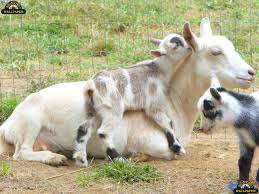Productivity of taggar goats as affected by sex of kids and litter size
Keywords:
Taggar, Goat, Production, Reproduction, Concentrate ration, Dry land, SudanAbstract
The experiment was conducted in Taggar goats to evaluate the effect of two different levels of protein and energy in ration on some reproductive and productive traits. Sixty two (62) kids of Taggar goats were used in this experiment. Animals were allocated to three feeding regimes in a complete randomizes design according to live body weight. The results indicated that supplemented does secured higher litter size 1.50 and 1.33 compared with control group 1.2. Where kidding rate was high in supplemented groups 100% compared with control group 93.8%.Body weight was heavier at time of kidding and time at weaning for supplemented does compared with control does. These results indicated that supplementation reduced body weight losses through lactation period. The kidding interval for the supplemented does was shorter 247.81±8.38 and 242.60±7.88 days for does in groups B and C respectively compared with does in control group 288.94±6.84 days. Similar the service period had been reduced in supplemented does compared with control does, the respective values were 74.32±4.96, 83.46±4.67 and 93.08±4.22 days for groups B, C and A respectively. The results of milk analysis indicated that supplemented does produced higher protein, lactose and total solid content whereby the fat content was higher in control does. The supplementation which given to does had reduced the number of aborted and abortion and mortality rates compared with the unsupplemented does. In conclusion the investigated environmental factors showed an impact on both reproductive and productive traits of the Taggar goats under the rangeland farming system.References
Abu Nikhaila, Abdel Moneim, M.A., Hag, E.L., Khalid, O., 2003. Evaluation of growth rate of Sudan Nubian and crossbred kids. U. of K. J. Agric. Sci, 11(1), 134-143
Beischer, D.A., Pattie, W.A., Norton, B.W., 1992.Environmental factors influencing the growth of Australian feral goats. Small Rumin.Res7 (4), 182
Bushara, I, Abu Nikhaila M.M.A. A., 2012. Productivity Performance of Taggar Female Kids under Grazing Condition. J Anim Prod Adv, 2(1), 74-79
Dadi, H., Duguma, G., Shelima, B., Fayera, T., Tadesse, M., Woldu, T and Tucho, T A. 2008. Non-genetic factors influencing post-weaning growth and reproductive performances of Arsi-Bale goats. Livestock Research for Rural Development: 20 (7)
Das, S.M., Rege, J.E.O., Shibare, Mesfin. 1996. Phentypic and genetic parameters of growth traits of Blended goats at Malya, Tanzania. In: Small ruminant research and development in Africa,Proc.3rd of African small ruminant research network.UICC,5-9Dec1994,Kampala,Uganda.
Elamin, E.M., Mudawi, T.M.A., Abdullah M.K., 2007.Characterization of the Tagger goat in Eldelang area in the Nuba mountain in South Kordofan, Sudan .Conf. on genetic resources of the Sudanese livestock wealth.Khartoum.5-6 March.
Gubartalla, K.E., Abu Nikhaila, A. M., EL khidir, O.A., 2002. Some observations on performance of first kiddding Sudanese Nubian goats.Sudan J. Anim. Prod, 15, 43-54.
Hanford, K.J., van Vleck, L.D., Snowder, G.D., 2006. Estimates of genetic parameters and genetic trend for reproduction, weight, and wool characteristics of Polypay sheep. Livest. Sci. 102, 72–82.
Ikwuegbu, O.A., Njwe, R.M., Tarawall, G., 1996. On-farm reproductive performance of the West African Dwarf goat at Ganawuri in the sub-humid zone of Nigeria. Tropical agriculture; 73, No1, pp. 49-55 (26 ref.)
Kosum, N., Taskin, T., Akbas, Y., Kaymakcia, M., 2004.Heritability estimation of birth and weaning weights in Saanen, Bornova and Saanen x Kilis goats. Pakistan. J. Biol. Sci; 7(1), 1963-1966
Lyatuu, E.T.R., Das, S.M., Mkonyi, J., 1994. Some production parameters of Belended goats in semi-arid regions of Tanzania. In: Small ruminant research and development in Africa, proceedings of the 2nd biennail conference of the African small ruminant research net work, AICC,7-11 Dec,1992, Arush, Tanzania.
M.A.R., 2007. Minstry of Animal Resources, Statistical Bulletin for Animal resources, issue No (15-16).May, 2007.Khartoum,Sudan.
Madibela, O.R., Mosimanyana, B.M., Boitumelo, W.S., Pelaelo, T.D., 2002. Effect of supplementation on reproduction of wet season kidding Tswana goats. South African Journal of Animal Science 32, 14-22
Mandal, A., Neser, F.W.C., Rout, P.K., Roy, R., Notter, D.R., 2006. Estimation ofdirect and maternal (co)variance components for pre-weaning growth traits in Muzaffarnagari sheep. Livest. Sci. 99, 79–89.
Marai, I.F.M., Daader, A.H., Hassan, F.A., Abu-Ela, A. A., 2000. Anglo-Nubian reproductive performance traits, under Egyptian environmental conditions. 7th Inter. Conf. on goats hold in France 15-21May; P, 419-420.
Mtenga, L.A., Kifaro, G.C., Belay, Berhanu,. 1994. Studies on factors affecting reproductive performance and mortality rates of Small East African goats and their crosses. In: Small ruminant Research and Development in Africa, Proc.2nd Biennial Conference of the African Ruminant Research Network. ILRA, AICC,7-11 Dec,1992,Arusha,Tanzania. P.69-74.
Rosales, N.C.A., Urrutia, M.J., Gamez, V. H., Diaz, G.M.O., Ramirez, A.B.M., 2006. The influence of feeding level on the reproductive activity of Mexican native goats during the reproductive season. Tec Pecu. Mex, 44(3), 399-406.
Portolano, B., Todaro, M., Finocchiaro, R., van Kaam, J.H.B.C.M., 2002. Estimation of the genetic and phenotypic variance of several growth traits of the Sicilian Girgentana goat. Small Rumin. Res. 45, 247–253
SKDP 2000. Southern Kordofan Development Program, Volume (1),Main Report. No. January 2000.Ibid p.xiii.
Song, H.B., Lim, H.J., Lee, S.J., Hong, K.C., 2000. The reproduction of offspring of dams selected by kidding intervals and litter size in native Korean goats. In: Proceeding of the 7th Inter. conference on goats.15-21 May 2000. France. pp: 256-257.
SPSS, 1999. Statistical Package for Social Science version 10.
Walkdem-Brown, S.W., Bocquier, F., 2000. Nutritional regulation of reproduction in goats. In: Proceeding of the 7th inter. Final Conference on goat- 15-21 may 2000- France- 389-395.
Zeleke, Z.M. 2007. Envirnmental influences n pre-weaning growth performances and mortality rates of extensively management Somali goats in Eastern Ethiopia. Livestock research for rural development, 19(12).
Zeshmarani, S., Dhara, K.C., Samanta, A.K., Samanta, R., Majumder, S.C., 2007. Reproductive performance of goats in Eastern and North-eastern India. Livestock Research for Rural Development: 19 (8).

Published
How to Cite
Issue
Section
Copyright (c) 2013 I. Bushara, A.M. Abu-Nikhiala, A. O. Idris, D. M. Mekki, M.M. M. Ahmed, A.M. M.A. El-Hag

This work is licensed under a Creative Commons Attribution-NonCommercial-NoDerivatives 4.0 International License.



